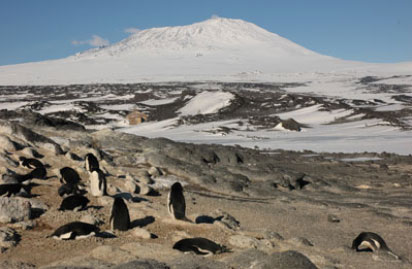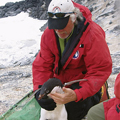Whales and Penguins

I guess I might as well show you, the reader, what the view is from the other direction. This picture wasn’t taken from the RacTent, which is hiding behind a hill and snowdrift to offer us a bit of protection from the southerly blasts. To see to the east takes a bit of a walk, and one might as well walk a bit farther for the view below: Mt. Erebus, a quietly active volcano (it has a bubbly lava lake), is about 13,000 feet high. The Cape is actually a series of lava floes that project out into the sea. The penguins here are nesting on an outcrop of columnar basalt that was worn down by the West Antarctic Ice Sheet during the last glacial maximum (25,000 to 12,000 years ago).The structure in the middle ground is much more recent: Shackleton’s hut from his 1909-11 expedition.
Two days ago we saw the first whales of the season. Jean was standing on the ice at Black Sand Beach, and a group of Emperor penguins popped out of the water right by her. A few seconds later she saw some killer whales not too far off. A bit later, in the same vicinity, the penguins were still standing by the ice edge and the killer whales were hanging out a few hundred meters out. Judging from their size, I’d say they were the “Type-B” killer whales, the ones that prey mostly on warm-blooded creatures like seals. [Editor’s note: In Antarctica, there are three varieties, or subspecies, of killer whales, also known as orcas. The three types, “A,” “B,” and “C,” are distinguished by their size, markings, and diet. Type-A orcas roam ice-free waters and prey on minke whales primarily. Type B hunt seals and penguins and can be found roaming under and around pack ice. Type C, also pack-ice hunters, are fish eaters.] In this group were nine whales: a male, five females and two calves. “Type B” whales are bigger than the more common (in these parts) “Type-C’” killer whales, which eat mostly fish.
We also saw, later, three minke whales that were breaching not too far off our coastline. This is a bit earlier than we’ve seen them in other years by about a week. I’m glad the minke whales are here and not out where the Japanese whalers can get them. I heard that even the U.S. has asked the Japan whalers to cease their ‘scientific’ take this year. The Japanese are not just taking minke whales, but humpbacks as well. I heard that the Japanese were asking the New Zealanders and Australians not to allow the Sea Shepherd Society vessel to come into port in their countries [Editor’s note: Sea Shepherd is an environmental organization that frequently protests and interferes with whaling vessels at sea. Last year, the International Whaling Commission granted permission for Japanese whalers to take humpback whales in the Ross Sea.]

Last season, bless their hearts, the Sea Shepherds harassed the whalers well. I wonder what the Japanese are threatening: not to buy the lamb and lumber of NZ or to raise the price on Toyotas? I’m amazed at the U.S. statement, or lack thereof. While the U.S. scientists have been arguing against the Japanese whaling for some time, the higher government has been silent, perhaps not wanting to disrupt the ‘coalition’ of Iraqi forces.
In any case, when the minke whales arrive in larger numbers, and the type-C killer whales, too, we can expect the penguins to have more difficulty finding food. These whales go after the same food as the penguins, and take much more of it in one gulp! When the whales are around, the penguin foraging trips are longer, and the penguins have to dive deeper. The penguins switch from eating mostly krill to eating fish at that time as well. It’s a very interesting interaction that surprised us when we discovered it. Without the weighbridge, we would not have detected the changes in foraging trip duration. If this were not part of the Ross Sea, either, we would not have detected this, as the Ross Sea is the last ocean on earth where all the parts are still in full (well almost full) force and all processes are functioning as they have for millennia. Elsewhere the whales and fish have been wiped clear. But more on that later…..










love the pic
I am the newest member of ‘Steve’s Whale One’. A whale watching vessel off the east coast of Australia based at Mooloolaba. We are experiencing some fantastic behavours in the warmer waters as the whales head back down and this is strengthening my love of the Humpback whale. As I am new to Marine work and as a MC/Host of Australia Zoo and now host that speaks on the boat, the information you give is a wealth of knowledge. Giving me and others a better understanding of just how the cycle works. Thank you for your time and efforts.
i love whales